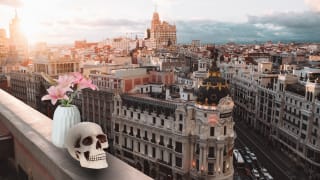Future-proofing our cities against 21st century crises
In many ways, cities are living, breathing entities – and they’re evolving just as we are. We reached out to Jonathan Woetzel, Director of the McKinsey Global Institute, to understand how the crises of the 21st century are shaping the development of our cities.
Thank you for joining us, Jonathan. It’s been a turbulent year to say the least, and we’re looking forward to getting your insight on how you think we’ll be seeing cities evolve. What do you think the biggest impacts will be on the development of cities from 2020?
I think that the impact on cities will first of all be a response to the health challenge, one that ultimately comes down to a confidence challenge on the part of people who live in cities. Restoring that confidence is critical to getting what we want out of cities. The history of mankind is that we have always found ways to do so; no matter what the threat is to urban life, whether it’s marauding bandits, or cholera, or fire… Cities and the people who inhabit and visit them find ways to respond.
And so too this time. Our health challenge clearly has a lot to do with crowding, with sanitation, and we’re going to have to solve those things. We’ve done so in the past, and I believe we will do it this time. There are a lot of specific implications for buildings, for transport, for public health. But at the same time, we have the second order consequences of what this crisis of confidence has done to life in the city.
This recession is ultimately a high-income recession that is throwing a lot of low-income people out of work. It’s opening up even further the divide in our urban life between the haves and the have nots. But I believe that second order implications will help encourage change to repair the damage. To recognise that a house divided cannot stand, and that we need to help every member of society fully participate in the life of the city, by repairing our social contracts around housing, health, education, and income. We need to fix those divides, or we will truly see an unpleasant city, far worse than we have today.
In terms of the practicality of that, do you think we’ll see more changes in urban design? You mentioned crowding and sanitation – how would you predict that would manifest itself?
In a word, density good, crowding bad. We have to have a better sense for personal space, but a lot of that has to come from reimagining the contract of what’s an acceptable amount of personal space for everybody – whether it’s in an elevator or in your living area. We can do better. I think we’ll hopefully see a better investment in affordable housing as a public health initiative, as well as the rethinking of office space.
There are two ends of the spectrum. Some things will pass away. For example, some of the over-built retail probably won’t come back, reflecting consumption patterns shifting towards online, but other areas within the city - particularly around where people live - will flourish as people rediscover a sense of place and the opportunities to have a less crowded experience closer to home.
It’ll vary, but I don’t expect everyone can or will work from home. I think we can all universally say we have zoom fatigue at this point. There’s certainly a balance between virtual and real that we’re developing, but I’m not a believer in the flight from cities, nor am I a believer in the digital lifestyle, both of which I think are harmful to the human species. However, we do need to find a way to make the in-person experience that much safer for everybody.
In the UK, we’ve definitely seen a retreat from the city centres. The business districts are almost abandoned because once people started working from home, there was no other use for those spaces. How can we repurpose these spaces to better suit our new ways of living and working?
There’s a lot of wasted space in cities, usually because of legacy restrictions on the use of the space, or because of zoning that essentially forbid development in large portions of the city, or because of this mono-pattern of development that we sometimes see around government or other usages. So yes, I think encouraging a mixed usage philosophy is key.
This is actually very much in line with market development. If you look at cities that are truly vibrant and integrated – Tokyo comes to mind - everything is all mixed up. There isn’t any rhyme or reason, per se, and the integration of residential, commercial, business, and government works well. It’s what makes for a much more vibrant and distinctive neighbourhood character.
I think achieving this will change the character of our neighbourhoods. Particularly in America, there’s an idea that changing the character of your neighbourhood is impossible. But if the character is fundamentally unhealthy in a physical, social or environmental sense, it should be changed, and it needs to be changed. A lot of this will come as we adopt different ways of thinking about what is the healthy nature of a neighbourhood. And that should be organic. Young people have different ideas than their grandparents do, and when they ultimately get their chance to put their ideas into practice, it will come.
For forty years, the basic town planning principle of Singapore has been strong smart neighbourhoods; this idea of live, work, eat, play, and that it should all be available to you without having to trek across the city. The best trip is a trip you don’t have to take. When you talk about mobility, the underlying goal isn’t mobility, it’s access. Bringing access to services to the person, whether it’s education, healthcare, recreation, employment, you name it – that’s a big part in having a liveable environment.
That said, cities grow by creating choice. And sometimes that means you have to go elsewhere to get a different experience, which is why cities tend to grow in line with the technology of mobility. Before, we had cities that were the size of how far you could walk in an hour or two because that’s how far you could travel. That’s why all the European cities are very dense, because they’re a couple of thousand years old, and that’s how you got around.
And then it was expanded to how far a horse could go. And then they expanded to how far a car could go. We’re at the car length, but a four hour commute isn’t practical or healthy thing. Technology and mobility does allow us to think about cities at a hyper scale, though. Tokyo again is a good example of this. It’s a hyperscale that is comprised of many, many neighbourhoods and each of these neighbourhoods is integrated to allow people to have that live, work, eat, play experience at home if they want to.
And obviously it helps to be more resilient.
Exactly. Some people are talking about a post-pandemic world, but there is no ‘post’ here. This is a pandemic world now. We’ve had three pandemics in the last ten or fifteen years now, so why would it stop? This is the new normal, and that will trigger a whole set of responses in allowing people to feel confident and safe that no matter what comes up, the city will be able to handle it.
I’m in Shanghai right now, and the Chinese model is interesting because each city has its own track and trace app. You have to sign in when you arrive in the city so that the local CDC know who you are, where you’re staying, and you have to share this QR code when you enter a building. If it turns green, great, and if it turns yellow, people ask where you were so they can check if there was an outbreak there. It’s very local in that sense. There’s an application infrastructure that stretches across cities and across the nation, but the actual delivery is very local. That’s important – this has to be owned by cities, they have to take charge of their responsibility to help their residents and their visitors feel safe.
One of the things we noticed early on was that a few places seemed to be losing sight of the sustainability challenges in order to focus on rapid economic recovery, but it’s an essential element of building a resilient future. Do you have a suggestion for a city or country that’s struggling to balance short and long-term demands?
First of all, everything is a public health issue, and anything that gets restarted needs to be in line with what’s appropriate and safe at that stage to maintain health and confidence in that city. That’s a priority. But that said, assuming something can be restarted, then how and what to restart?
There’s been a lot recently about shovel-ready infrastructure investments as a restart model, but I personally feel that’s a bit overblown. Going back to a model which says we’re going to get things started by building a tunnel… Who are you expecting to go in there? There’s a whole class of inter-city transport infrastructure that’s not going to need a lot of rebuilding any time soon.
We need restarts that are consistent with an equitable and long-term environmentally sound approach, and in that, there is no shortage of opportunities. Housing retrofits would be a good start. Rethinking our single-family homes to introduce accessory dwelling units or duplexes – or to retrofit for environmental standards – would employ a lot of people while creating homes and housing which are safer for many more. Big mega-projects which are intended to employ highly skilled professional labour to serve a largely wealthy population are probably less attractive than the things you’re doing in the local neighbourhood, which use local labour, and do social good.
And obviously digital infrastructure - we’ll see a whole wave of growth in last mile delivery, both in terms of technology and autonomous vehicles, as well as warehousing and the repurposing of retail space. All of which can be done in an energy efficient way. And energy itself in terms of decarbonising the power sector. The growth in energy will be in renewables, whether that’s solar panels on your rooftop or your office building, or rethinking composting in the city. There are lots of things that could and should be done to decarbonise the power sector. I think there are a lot of opportunities both to increase city efficiency and to support a decarbonisation pathway.
Smarter cities are often seen as a key part of the solution for 21st century crises – how technology can help us respond better to pandemics and the other crises that have helped to shape cities over the centuries. What role do you see technology having in shaping a city’s response to these challenges, and are there any cities you’ve seen who are doing this well?
Technology has been the factor in helping urban residents feel safe. This is both in terms of enabling economies to continue to function, whether that’s working from home or digitisation of processes, or it’s in the assurance of lives, from testing to track and trace to public communications and transparency – all that’s a function of technology. Cities that have their technology act together and integrated into their public response are doing much better. They’re coming out of it faster; they’re enabling lives to go on as normal. It’s a credit to them and it shows what’s possible.
This technology makes a difference in the quality of response of cities from previous episodes, and I think it will continue to sharpen the divide between those cities who can use tech and those who can’t – and those who are able to use the technology will be more attractive, will build more confidence, will grow faster, and will create more opportunities for employment and innovation than those who are unable to do so.
I hesitate to compare, but it’s hard to avoid the realisation that, generally speaking, Asian cities are doing better. They adopted more technology, they reduced their case counts, they’re bouncing back economically faster, all the high frequency indicators are up. There’s a quite a bit to be learned from Asian cities.
What’s also interesting is that in contrast to many previous crises where it was the government telling you what to do, this has very much been a public-private collaboration. Whether we’re talking about Samsung or Huawei, there are private companies that are coming up with solutions to public problems, and that’s very different to how SARS unfolded, for example.
As a final thought, if you could see into the future, what would you predict that life in a city look like in 30 or 50 years?
It’s going to be amazing! Compared to what we have today – what could you have imagined 50 years ago about life in 2020?
If we’re looking at trying to make the comparison for the leading-edge cities, what we all aspire to in city life is a healthy life, to grow, to learn, to exercise our talents. We want a safe city. A sustainable city. This is a very binary belief – either you believe in the dream or you don’t, so I choose to believe in the expectation that gives us something to shoot for. And I don’t see any challenges in front of us that we can’t overcome with a sufficient level of engagement, initiative, and commitment. Whether it’s environmental, economic, or social, the future of a city is the future of us. It’s who we are. We are the species who lives in cities, there’s no possibility in divorcing ourselves from our desire to interact with each other in a frequent and intensive way.
But how we do that will change radically. The technology of mobility will evolve. We might find archipelagos of cities which have a common governance framework but are composed of tens of thousands of communities that have a vibrant life, a fifteen minute life. From a human standpoint, that fifteen minute concept works very well because it’s one of those aspects of your day that’s fundamentally driven by biology – how much of your day do you have and how do you divide that? Fifteen minutes seems like a reasonable expectation of what you should have in your life, as opposed to a two hour city which gives you less choices to make with your time.
We’ll see differences in form, we’re going to see movement in mobility, we’re going to see transformation in our energy system, we’re definitely going to see vast growth in our digital life – which doesn’t mean we’ll lose the physical, but we’ll have to integrate better – ‘phygital’, as they call it in the retail space. And bio! The bio revolution is coming and that will make a big difference in terms of life extension and our physical resiliency, to address many of the disease vectors through much better genetic level medicines. I hesitate to predict as I’m not much of a futurologist, but the betting should be on the cities. Cities are what has carried us forward, and I believe they will continue to do so.
What a wonderful statement to end on. Thank you, Jonathan.
Jonathan will be joining us at City Nation Place Global this November to explore the impacts of new design thinking on urban life following the crises of 2020. Find out more about City Nation Place Global.
Related reading:
What does 5G mean for place marketing, placemaking and place branding?
The secret to Lithuania's domestic tourism success
People make places: rebuilding from the inside out
Has the pandemic killed soft power?
The politics of space, culture, and placemaking in post-COVID place branding









